Abstract
This study presents a comprehensive assessment of energy efficiency and conservation strategies in institutional buildings, using the Riyadh Reformatory Building (RRB) in Saudi Arabia as a case study. The analysis focuses on meeting the operational and safety requirements of the facility while aligning with the regulatory standards of the Saudi Arabian Standards Organization (SASO) and the Saudi Building Code (SBC Part 401), particularly in relation to electrical installations and the Energy Efficiency Ratio (EER) labeling system. Through simulation and evaluation, the study demonstrates that replacing traditional lighting with LED systems results in a 74% reduction in energy consumption. The application of programmable temperature regulators further reduces annual cooling energy use by 5.1%, with associated cost savings reaching 6.2%. Additionally, the research highlights the significant influence of window properties, thermal insulation, and water heater controls on energy performance. Notably, adopting high-EER air conditioning units leads to a 28.4% decrease in annual cooling energy consumption. Collectively, the findings underscore the effectiveness of integrated energy management practices, including optimized building layout, high-efficiency systems, and smart control technologies, in achieving substantial energy savings and operational cost reductions in institutional settings.
1. Introduction
1.1. Motivation and Incitement
The Ministry of Energy in Saudi Arabia has developed a comprehensive national strategy aimed at enhancing energy efficiency across various sectors. This strategy focuses on reducing energy waste, preserving natural resources, and improving the performance of electrical devices and equipment. A significant component of this initiative is the establishment of the Saudi Energy Efficiency Center (SEEC), which leads efforts to rationalize energy consumption in the Kingdom. SEEC’s programs target multiple sectors, including residential, commercial, industrial, and governmental facilities, aiming to raise awareness and implement energy-saving measures [1]. In parallel, the development and enforcement of the Saudi Building Code (SBC) [2], particularly the Energy Conservation Requirements (SBC 601) [2], have been instrumental in promoting energy efficiency in building designs. These regulations mandate the application of thermal insulation and other energy-saving practices in new constructions and renovations [2].
To further support research and development in energy conservation, Saudi universities have established dedicated research chairs. For instance, the Zamil Group Chair for Electricity and Water Conservation at King Saud University focuses on developing innovative solutions for sustainable energy use. Practical applications of these initiatives can be observed in specific projects, such as the energy conservation measures implemented in the Riyadh Reformatory Building (RRB). Studies on such facilities provide valuable insights into the effectiveness of energy-saving strategies in institutional settings.
1.2. Literature Review of Some Existing Works
Recent studies have made significant strides in advancing energy conservation and efficiency in buildings through innovative technologies and modeling techniques. A fuzzy logic-based model was proposed to enhance Brazil’s RTQ-C classification system by introducing sub-levels and addressing parameter uncertainties, thereby enabling more accurate and effective energy efficiency assessments for public and private sectors [3]. In hot summer and warm winter regions, a multi-objective optimization framework (Hyperopt-CatBoost-SPEA2) was developed to improve office building performance, achieving notable reductions in energy consumption (up to 30%), enhanced lighting efficiency (60%), and improved thermal comfort (38%) [4]. Furthermore, the indoor thermal conditions of traditional houses on the Western Sichuan Plateau were analyzed, leading to energy-saving strategies that cut winter heating load by 56.5% and identified biomass heating as the most cost-effective option, contributing to sustainable energy use in culturally significant buildings [5]. To reduce heat gain while maintaining daylight, a spectrally selective polyethylene film was introduced, capable of lowering indoor temperatures by 10 °C and reducing energy consumption by up to 31.9%, offering a passive solution for energy-efficient window design [6]. On the lighting front, an automated LED control system utilizing ambient light sensing achieved a remarkable 75.65% reduction in energy use, underscoring the potential of smart control systems in enhancing building energy efficiency [7].
Recent advancements in Artificial Intelligence (AI) and the Internet of Things (IoT) have significantly enhanced energy efficiency strategies in institutional buildings by enabling intelligent, real-time, and adaptive energy management systems. AI techniques, such as machine learning, reinforcement learning, and physics-informed neural networks (PINNs) are now widely used to optimize HVAC operations, forecast energy demand, and automate decision-making processes [8,9]. In [8], the application of LSTM with Rolling Window Cross-Validation enabled accurate prediction of indoor air temperature (IAT), facilitating adaptive energy management and efficient climate control in dynamic environments, whereas, a physics-informed neural network (PINN) framework was applied to optimize HVAC system control in real commercial buildings, improving energy efficiency by 23.2% and demonstrating the effectiveness of integrating physical knowledge into machine learning models for smarter building operations [9]. IoT-enabled sensors and control systems provide continuous monitoring of building parameters, such as occupancy, temperature, and lighting levels, allowing for automated adjustments that reduce energy waste and enhance occupant comfort [7]. Predictive models built with algorithms like LSTM and CatBoost can anticipate usage patterns and external conditions, enabling proactive load control and energy peak shaving [4]. Furthermore, the integration of AI with Building Energy Management Systems (BEMS) allows for centralized control, fault detection, and performance optimization across subsystems, making institutional buildings more resilient and sustainable. These innovations mark a transition from reactive to self-optimizing infrastructures, aligning with global trends in digital transformation and environmental stewardship.
On the other hand, the authors in [10] examined various energy-saving strategies tailored for hospital and healthcare facilities. It highlighted how energy consumption in hospitals varies based on factors, such as usage patterns, building construction year, insulation quality, climate conditions, maintenance practices, and the age and efficiency of mechanical and electrical equipment, as well as the effectiveness of energy management practices. Al-Shaalan in [11,12] reposed actions to alleviate power outages causing energy to cease in the residential sector. He revealed also that the residential consumer bears an immense role in adopting and adhering to certain energy consumption behaviors when using his domestic appliances and equipment. Snead in [13] suggested in his report specific rules and measures for various consumer categories that can be applied and adopted in the process of energy utilization and conservation. The authors referenced in [14,15] demonstrated that employing consumer incentive strategies can effectively lower energy consumption to reasonable levels. Additionally, findings from [16] indicated that ongoing education and awareness campaigns can motivate individuals to conserve energy, leveraging factors, such as environmental concerns, familial responsibility, lifestyle benefits, and incentives. Moreover, ref. [17] employed a city-wide approach to assess energy conservation policies in residential areas, considering factors like occupant behavior and the use of energy-efficient appliances. Furthermore, the authors in [18] proposed an idea based on thermal relief and energy saving in the dwellings. They emphasized the potential of well-designed natural or partially natural ventilation systems to decrease the energy demand for cooling within buildings. In [19], the authors discussed a practical and economical way to conserve energy in premises and dwellings based on certain specific behavior. Shimoda et al. [17] evaluated energy conservation measures on a city-scale using detailed end-use simulation model. To improve energy efficiency in buildings, this study presents a multi-objective decision model that evaluates an infinite number of alternative measures based on criteria, such as annual primary energy consumption, annual carbon dioxide emissions, and initial investment cost [20]. This model addresses the limitations of traditional methods like simulation and multiple criteria decision analysis by enabling a more comprehensive examination of potential solutions. In [21,22], they highlighted the benefits of employing automated LED lighting systems in buildings for enhanced performance and reduced energy consumption. They demonstrated that the implementation of automated energy-efficient lighting, particularly LED luminaires, significantly lowers energy consumption in residential settings. The annual report in [22] introduced the Energy Efficiency Regulations (EER), mandating compliance in the design and manufacture of electrical household appliances and major electrical equipment. This initiative included the introduction of energy labels for essential household appliances like air conditioners, washing machines, refrigerators, and freezers. This effort resulted in a substantial reduction in overall electricity demand and alleviated a significant portion of the financial burden on consumers. The authors in [23] investigated energy conservation in a small microgrid for a new hospital in Riyadh, complying with the Saudi Building Code (SBC part 601). The hospital has implemented energy conservation measures, including upgraded Heating, Ventilation, and Air Conditioning (HVAC) systems, efficient lighting, improved thermal insulation, and enhanced window materials. Using Autodesk Revit and eQUEST for comprehensive energy simulations, the study evaluates various energy-saving measures, achieving an annual energy savings of up to 19.82% and more than 100,000 SR in yearly energy savings, along with over 700,000 SR saved in initial costs through Value Methodology. Alrubiah et al. in [24] presented a novel method based on using daylighting systems for educational buildings in humid atmosphere. Lombard et al. in [25] offered useful information on buildings energy consumption that can be used in power system planning and operation. Chi-Ming and Yao-Hong in [26] arrived at designing energy-saving capability of building designs in domestic houses in Chinese town. The authors claimed that this design yielded the expected meaningful results. Alajlan et al. in [27] discussed some possible methodologies implementing efficient instruments toward energy conservation. Melo et al. in [28] examined a practical building energy consumption model for a case-study in Brazilian city. They revealed that this model is accurate and capable of being adopted and used for building energy conservation. The author in [29] offered a study based on practical and effective rules for reactive cooling and energy consumption in housing. This study was done on some surveys in addition to personal communication for collecting data and information. The authors in [30] claimed that the integrated utility-consumer strategies for demand management can be vital and effective in energy conservation and at least cost. Chowdhury et al. in [31] offered work based on cooling comfort evaluation for various low-energy cooling-tools applied to an office building in a tropical climate. In [32], an analysis based on sectorial energy conservation in Malaysia has been performed. This analysis was distributed questionnaires based on the willingness-to-pay to avert energy interruption and energy cease in Malaysia. Homoud et al. in [33] presented an estimation of observing energy usage and cooling comfort conditions in warm climates. The authors claimed that they obtained encouraging and meaningful results from their observation and assessment.
The objective of reviewing prior studies and methodologies, which have introduced diverse modeling techniques and simulation approaches for building energy conservation, is to extend, substantiate, apply, and develop these models in the present paper. Energy conservation in buildings relies on statistical data, simulation, modeling, surveys, and various approaches. The key findings indicate that air conditioning (AC) stands as the primary contributor to electric energy consumption, followed by lighting in buildings. Opting for high-efficiency air conditioners with Energy Efficiency Ratios (EER) compliant with Saudi standards is recommended. Studies emphasize the importance of leveraging natural lighting to diminish reliance on artificial lighting and the use of energy-efficient lamps instead of energy-consuming compact fluorescent lamps (CFL). Additionally, studies underscore the significance of employing insulating glass in windows to minimize radiation and heat transfer. Glass windows should be selected based on considerations like transparency, shading, visibility, and natural light input. Insulation in the outer envelope and roofing are crucial for minimizing external heat or cold leakage. Some studies advocate against dark-colored surfaces and external walls due to their impact on direct sunlight absorption, leading to increased latent heat. Lastly, employing sensors and control devices for building AC equipment, and lighting is recommended to operate only when necessary and shut down during periods of inactivity.
The main objectives and the major contributions of this work can be summarized as follows:
- ▪
- Significant Energy Reduction via Integrated Measures: By applying a comprehensive set of energy-saving strategies, lighting upgrades, HVAC improvements, insulation, and appliance control, the study achieved 41% annual energy savings in the Riyadh Reformatory Building.
- ▪
- Demonstrated Effectiveness of LED Lighting: Replacing traditional lighting with LEDs led to a 74% reduction in lighting energy consumption and a 14.7% decrease in cooling costs, showcasing the compounded benefits of efficient lighting on HVAC loads.
- ▪
- Impact of High-Efficiency HVAC Systems and EER Standards: Upgrading to air conditioners with higher Energy Efficiency Ratio (EER) values (from ~9 to 11.8) reduced annual AC energy consumption by 28.4%, emphasizing the role of regulatory compliance (SASO standards) in institutional energy efficiency.
- ▪
- Enhanced Thermal Performance through Insulation and Window Optimization: Improvements to wall and roof insulation, along with the use of double-glazed, shaded windows, cut energy use for cooling by up to 36%.
- ▪
- Adoption of Smart Control Systems for Load Management: Utilizing programmable thermostats and scheduled water heater operations led to additional energy and cost savings (e.g., 5.1% HVAC load reduction and 33% water heater energy savings.
2. Application to Riyadh Reformatory Building as a Case Study
It is realized that the reformatories buildings normally inhabit discern occupant’s types that necessitate confident measures and facilities that have to be provided for the security of such buildings and also for the safety, health and convenience of their confined occupants and to the staffs, caretakers and guards as well who either live-in (wardens, security guards) or work on a daily-time basis (employees) in that building. Riyadh Reformatory Building (RRB) (as a case-study) comprises an isolated area of 2 km2 at 40 km located south of Riyadh city and provided with all needed facilities and services (hospital, schools, factories, farms, bakeries, food courts areas, administrative offices, communications networks, buildings, furnished rooms for relative visitors, recreational areas, playgrounds, etc.).
The electric power received by the RRB from the local electric company (Saudi Electric Company, SEC, Riyadh, Saudi Arabia) at present time is within 9 MW (As shown by Figure 1 which depicts the monthly load demand) while, in fact, the RRB needs at least 27 MW to operate its entire facilities adequately, reliably, and satisfactorily. This power deficit creates several obstacles and inconvenience to the Reformatory, firstly, not being able, at the present time, to supply its present demand and secondly hindering possible future infrastructural expansion. The RRB monthly load for the years 2016–2018 is shown in Figure 1 and Figure 2 show the present power substations supplying the RRB which consist of regular and emergency supplies.
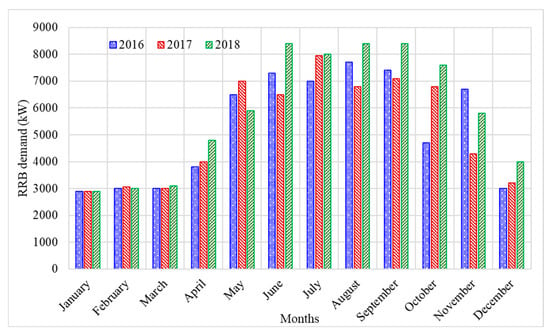
Figure 1.
The RRB monthly load for the years (2016–2018).

Figure 2.
Regular and emergency supplies.
3. Adopted Research Methodology
The adopted methodology revolves around the utilization of the programming simulation software, specifically “eQUEST, Version 3.64.” This software is purpose-built for building energy conservation simulations and proves valuable across all design phases, including schematic design. “eQUEST” is renowned for delivering precise and reliable results with reasonable computational effort and time.
In this work, eQUEST-based building energy simulation software—was selected due to its robust capabilities in modeling HVAC systems, lighting, building envelope, and control strategies. The simulation process involved several key steps:
- Data Collection and Input Preparation:
We gathered detailed architectural, electrical, and operational data for the Riyadh Reformatory Building (RRB), including:
- ▪
- Building geometry and layout (room sizes, orientation, wall and roof construction)
- ▪
- Electrical load components (lighting systems, air conditioning, water heaters)
- ▪
- Climatic data for Riyadh (monthly temperature profiles)
- ▪
- Occupancy patterns and operational schedules
- 2.
- Model Configuration in eQUEST:
The RRB model was created in the eQUEST schematic design wizard by specifying:
- ▪
- Wall and roof constructions with varied insulation materials and thicknesses
- ▪
- Window types (single, double, shaded), orientation, and shading coefficients
- ▪
- HVAC system types, operating conditions, and EER values
- ▪
- Internal gains due to lighting, occupants, and equipment
- 3.
- Scenario Simulation and Parametric Analysis:
A series of simulation runs were conducted to assess the energy impact of different energy conservation measures. These included:
- ▪
- Replacing traditional lamps with LED lighting
- ▪
- Introducing programmable thermostats for HVAC control
- ▪
- Modifying glazing properties and insulation levels
- ▪
- Adjusting EER values of air conditioners
- ▪
- Scheduling water heater operation using timers
- 4.
- Evaluation and Validation:
The simulated energy consumption results were validated against actual monthly load data (2016–2018) from RRB’s utility records. The simulations provided quantitative estimates of annual energy and cost savings under different scenarios.
- 5.
- Comprehensive Energy Savings Estimate:
Finally, all proposed conservation measures were integrated into a unified simulation model. The outcome demonstrated total energy savings of 41% annually, validating the effectiveness of the applied measures in reducing the energy demand of the RRB.
In the pursuit of establishing measures and methodologies for energy conservation in the RRB, the following procedures have been executed:
- ▪
- Compilation of all requisite data and information for simulation programming (building room count, areas, electrical equipment, lighting, etc.).
- ▪
- Adherence to the Saudi Building Code (Part 803: Energy Efficiency) requirements.
- ▪
- Prediction of the thermal behavior of buildings concerning their outdoor environment.
- ▪
- Assessment of the impact of daylight and artificial light within the building.
- ▪
- Identification of factors influencing energy consumption in the building.
- ▪
- In-depth analysis of various elements, such as air conditioning (AC), lighting, heating, ventilation, and HVAC systems, thermal insulation materials, shading, and envelope considerations using “eQUEST”.
4. The “eQUEST” Simulation Software
The eQUEST software, an acronym for Easy Quick Energy Simulation Tool, stands as prominent software developed by the Carrier Corporation and was initially released in 2002. This program encompasses various functionalities pertinent to HVAC system design, applicable across residential, commercial, and diverse building types. It facilitates the computation of system loads and designs, conducting simulations of building energy, energy audits, evaluations, analyses, and cost assessments. Operating in alignment with ASHRAE standards, the program incorporates two processors: the schematic processor and the development processor, along with an energy efficiency meter (refer to Figure 3). These processors enable both descriptive and quantitative analyses of building components, such as glass windows, roofs, walls, etc. Moreover, they address the impacts of air conditioning, encompassing cooling, heating, and ventilation effects. The user manual comprehensively elucidates the functionalities of these processors and program components, guiding users to generate graphs and computational results related to the performance and efficiency of devices and equipment installed in buildings.
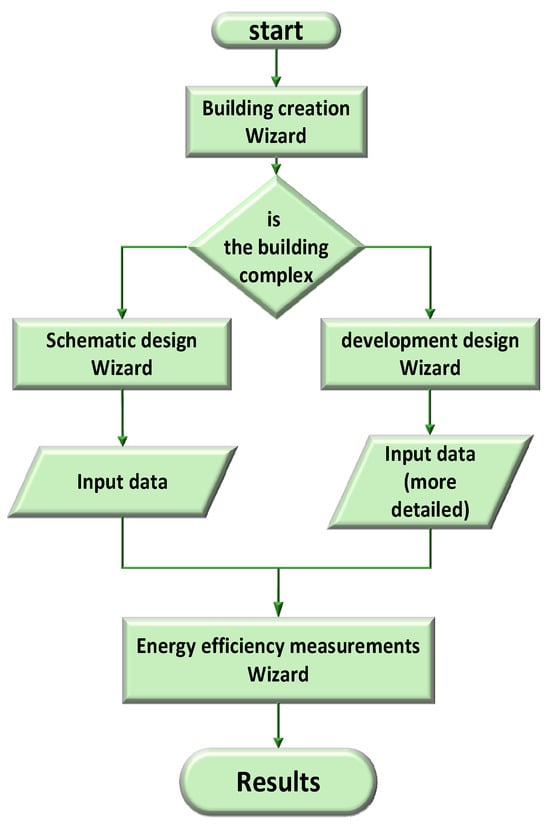
Figure 3.
Flowchart for the software used (eQUEST).
After a thorough examination of various studies and prior research focusing on strategies to optimize electric energy consumption in buildings, grounded in statistical data and utilizing computer-based methodologies, several key insights can be synthesized. Predominantly, air conditioning emerges as the primary factor influencing electricity consumption in large buildings, closely trailed by lighting. Consequently, the installation of high-efficiency air conditioning units conforming to Energy Efficiency Ratio (EER) standards outlined in Saudi regulations is recommended. Studies underscore the significance of harnessing natural light to diminish reliance on artificial illumination. Furthermore, is crucial for reducing unwanted solar heat gain, particularly in hot climates, such as that of the Kingdom of Saudi Arabia. Thoughtful selection and installation of glass windows, considering factors, such as transparency, shading, visibility, and natural light intake, are advised. The application of thermal insulation in the outer shell and surfaces of Residential and Recreational Buildings (RRBs) plays a pivotal role in minimizing external heat or cold transmission. Studies caution against the use of dark colors on surfaces and external walls due to their propensity to absorb direct sunlight, leading to increased latent heat. Lastly, advocating for the implementation of programmable (intelligent) or manual control devices for all RRB equipment, including adaptation and lighting, is recommended. These devices should operate only when necessary and be deactivated during periods of inactivity, such as breaks between regular memorization lessons, and preaching sessions. To aid researchers in understanding the climatic conditions, climate change, and temperature fluctuations in Riyadh, Saudi Arabia, and their correlation with electricity consumption across different months of the year, Figure 4 provides a comprehensive visualization of these dynamics. This figure illustrates the monthly variation of temperature and electric loads throughout the year in Riyadh, Saudi Arabia. There is a strong correlation between temperature and electric loads. As temperature rises, electric load increases, likely due to increased air conditioning usage in hotter months. The highest demand coincides with the peak summer temperatures, highlighting the critical role of climate in energy demand.
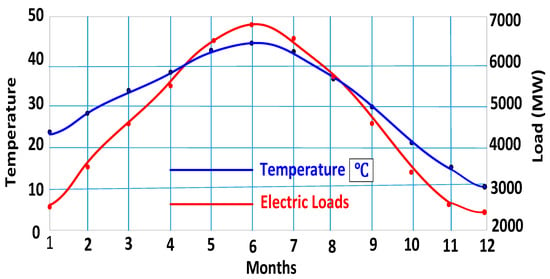
Figure 4.
Electricity consumption varies in response to temperature fluctuations in Saudi Arabia.
5. Procedures Adopted for Achieving the Objectives of This Study
The eQUEST simulation program was used in this study as a validated energy simulation model to evaluate and analyze the energy performance of the Riyadh Reformatory building. Table 1 shows the logic procedures for achieving the objectives of this study. The process of selecting and calibrating the model inputs was based on a precise scientific methodology, including the following:

Table 1.
Logic procedures for achieving the objectives of this study.
- Building Engineering and Architectural Characteristics
Accurate data were entered for the building’s floor plans, wall and roof orientations, the type of construction materials used, and the heat transfer coefficients of the various surfaces. These data were manually entered into the program based on architectural drawings and the results of field visits.
- 2.
- Thermal Properties of Structural Elements
The thickness and quality of the thermal insulation of walls and ceilings were calibrated in accordance with the Saudi Building Code (SBC Part 803) [2]. The properties of the glass used in windows (such as shading coefficient, thickness, and transparency) were also entered to accurately estimate thermal and radiant loss.
- 3.
- Air Conditioning and Mechanical Systems
The capacity and efficiency of the air conditioning units were determined according to the Energy Efficiency Ratio (EER) index issued by the Saudi Standards, Metrology, and Quality Organization (SASO).
- 4.
- Lighting and Electrical Equipment
Lamp types (incandescent, halogen, fluorescent, LED) were classified according to their wattage and number, and the resulting loads were estimated. The results showed that replacing conventional lamps with LEDs reduced energy consumption, reduced heat load, and improved air conditioning efficiency.
- 5.
- Weather and Climate Data
Local weather data for Riyadh, including summer peak temperatures, were entered to accurately estimate cooling loads. The model shows higher electricity consumption during the summer months due to heavy reliance on air conditioning.
- 6.
- Operating Behavior and Population Patterns
Operation schedules for lighting, air conditioning, and water heaters were calibrated based on questionnaires and interviews with correctional staff, as well as actual consumption data from the Saudi Electricity Company (SEC). User behavior, such as leaving appliances on after leaving the premises, which increases energy consumption, was also considered.
6. Results and Discussion
Numerous factors play a role in electrical consumption, with a significant dependency on factors, such as occupant behavior, building specifications, and operational electrical equipment. This study explores key factors influencing energy usage in the RRB, examining their impact on energy conservation and associated costs. The weather in Riyadh is characterized by high temperatures, averaging around 45 degrees Celsius, as illustrated in Figure 5, depicting the monthly temperature averages in Riyadh city. The temperature data have been collected from the national center for meteorology (available at https://ncm.gov.sa/ar/Pages/default.aspx, accessed on 2 June 2019).
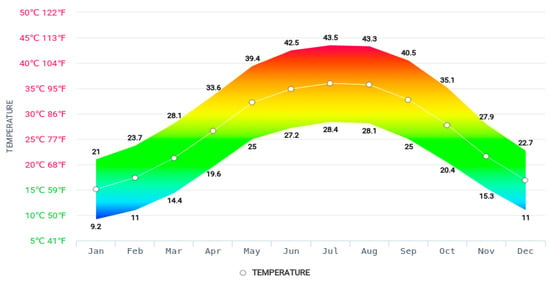
Figure 5.
Riyadh average monthly temperatures.
The high use of energy by RRB is attributed to the operation of the air-conditioners during the summer months and to the water heaters consumption during the winter months. It is difficult to reduce the amount of lighting in RRB for security reasons. Most types of lighting used are inconsistent with the provision of consumption standards because they consist of halogen and fluorescence. The light in RRB used CFL and lighting energy can account for about 30% of that. Some employees are careless in operating and keeping electric devices that reflect in increased energy usage within RRB. Many workers leave their workplaces without shutting off their electricity sources. Increasing the number of employees and occupants within the RRB, more than 6500 people have an immediate impact on energy use and the resulting cost. In the RRB, extensive heating or cooling are immensely needed. These two main sources are the major source of electricity consumption in RRB. So, the air-conditioners consume a large amount of electrical energy, about 55% of the gross energy consumed caused by a high load in summer season.
6.1. Effect of Lighting Type on the Load
The significant potential for energy savings through the adoption of energy-efficient technologies in lighting and motor systems. Specifically, upgrading to modern lighting solutions, such as LED technology, can reduce energy consumption by approximately 30% to 60%, while replacing outdated or inefficient electric motors with high-efficiency or variable-speed models can lead to energy savings of about 25% to 40% [27]. These estimates indicate that substantial reductions in electricity usage—and associated costs—can be achieved, depending on factors, such as the existing equipment’s condition, the technology adopted, and operational patterns. Overall, these figures underscore the importance of targeted technological improvements as effective energy conservation measures in both residential and institutional settings.
In hot-climate regions, such as Saudi Arabia, lighting can account for up to 30–35% of total electricity consumption in residential and institutional buildings, particularly where extended lighting hours and non-efficient fixtures are still in use [27]. Specifically, the reason behind this is based on findings from Saudi Arabia and similar hot-climate regions, where air conditioning and lighting loads are typically higher due to extended periods of high ambient temperatures and the need for security lighting in institutional buildings, such as the Riyadh Reformatory Building (RRB). Nowadays, all old used traditional lamps (incandescent and fluorescent) have been replaced by more efficient and less energy consumption lamps called Light Emission Diode (LED). Table 1 shows the related load when changing the light to LED; it shows the related load before and after conservation.
Table 2 proved that LED lamps are highly energy-efficient, consuming significantly less energy than traditional bulbs (74% reduction). By switching from traditional lighting (e.g., incandescent or fluorescent) to energy-efficient alternatives (e.g., LED lighting), one can reduce energy consumption by 74%. They convert a higher percentage of electrical energy into light, minimizing wasted energy as heat. It is possible for a designer engineer to choose the best efficiency and less consumption, and thus decrease the total capacity of the lighting, in addition to reducing the air-conditioning loads. To investigate the impact of replacement of incandescent lamps with Light Emission Diode (LED) and Compact Fluorescent Lamps (CFL) on reducing the air-conditioning load, it was assumed in a computer simulation of the program used in this study, which found that the total load of the air conditioner was decreased by 16% through the use of energy-saving lighting on the one hand and non-thermal radiation affecting the air conditioning in terms of its cooling capacity on the other hand.

Table 2.
Value the related load before and after conservation.
Table 3 shows that the annual cost of operating air conditioning when using incandescent lamps is SAR 83,464 while the cost of using energy saving lamps is SR 71,124, providing a saving rate of 14.7%. This can be increased by using energy-saving lamps. The most famous of these types are CFL and LED, which is characterized by high efficiency in the consumption of electric energy to give the same amount of light from incandescent lamps. For example, an 18-watt CFL lamp gives the same amount of luminance as a 100-watt bulb. Additionally, its virtual life is five times the age of the incandescent lamp, which makes it even higher in comparison to the incandescent bulb. The competition between CFLs and LEDs is very close, and the decision should be made in favor of one at the expense of the other based on the economic data and main objectives of the project itself.

Table 3.
Comparison of the expected cost of using incandescent lamps and energy-saving lamps.
6.2. Effect the Air-Conditions Energy Consumption
It is certain that the main cause influencing the high rise of consumption of electricity in the premises is air-conditioners for being responsible in constituting around 55% of the total energy consumed.
6.2.1. Effect of the Temperature Regulator Control on the Load of Air Conditioning (Total Cooling Capacity)
To investigate, analyze and realize the impact of the cooling regulator on total load of the air conditioning (total cooling capacity), it was assumed to operate at different intervals of times by controlling the programmable temperature regulator as shown in Table 3. The cost of the programmable cooling regulator is included in the total cost of air conditioning. The data shown in Table 4 indicate that the total air conditioning load in the second case is 5.1% less than the total air conditioning loads compared to the first case, and that the savings obtained from the thermostat control are 5.1%. It is important to note that this action can reduce the annual cost of cooling energy consumption by up to 6.2%, indicating the impact of the control thermostat to reduce annual consumption.

Table 4.
Comparison of air conditioning load in cases of presence and absence of cooling regulator.
6.2.2. Impact of Window Glass (Thickness, Shading, Area) on Air Conditioning Load
The glass in the windows used in the buildings and the percentage of its area for the wall area in which it is applied is a major factor in calculating the coefficient of heat transfer (air leakage to and from the inside of the building). The percentage of glass area for the total wall area should be within 10% or (11–15%) for double glass. As for RRB area of study, there is a commitment to this percentage as shown in the plans of RRB, as shown in Table 5. Because of the lack of technical specifications for the composite double glass inverter in RRB, an approximate value was assumed in the light of the data available in the ASHRAE. Additionally, a change in the window quality was determined to investigate the effect of the final heat transfer coefficient of the glass in the load of the air conditioning as shown in Table 5.

Table 5.
Effect of difference in the quality of glass on load of total conditioning.
Table 5 shows that the value of the thermal transfer coefficient for both double-glazed and transparent glass has increased the load of air conditioning by 2.7% and by 4.7%, respectively, compared to the double shaded glass (inverter). Table 6 shows the cost-benefit analysis and comparison to install the insulating glass instead of the transparent glass. Table 6 revealed that the difference between the use of double glass (reflector) and single glass (transparent) is 3799 SAR, and this difference can be considered in the recovery (retrieval) years and the six years of operating life expectancy of the type of glass used.

Table 6.
Comparison of the economic feasibility between double glass reflector and single transparent glass.
6.2.3. Effect of Insulation (Types, Thickness, Levels) of Walls and Ceilings on Air Conditioning Loads
It is crucial to design and apply thermal insulation in buildings to contain the temperature within them to reduce the leakage and transfer of heat from outside the building into the summer, and from outside to winter. Insulators, both in the wall and in the ceiling or both, are the most influential factors in the air conditioning loads. In this context, some of the standard specifications issued in this regard were adopted, the Saudi Standard (SASO 28793/2014) [34,35,36]. It was found that the insulators used in the RRB conform to the specifications required in that standard specification. To evaluate the insulation effect on various types of quality, walls, and ceilings thermal insulation thickness on the reduction of electric energy consumption, Figure 6, Figure 7 and Figure 8 show the effectiveness and efficacy of these measures and applications. Figure 6 shows the effect of insulations quality on energy consumption. This figure demonstrates that insulation significantly reduces annual energy consumption in buildings. Without insulation, energy use reaches 94%, while advanced materials like polyurethane reduce it to 58%. Among the materials compared, polyurethane and glass wool offer the best performance, followed by rock wool and polystyrene. The results highlight that higher-quality insulation leads to greater energy savings and improved building efficiency. In conclusion, insulation significantly reduces energy consumption, with potential savings of up to 36% compared to uninsulated buildings. Additionally, the type of insulation material matters—higher-performing materials like polyurethane and glass wool lead to greater reductions in heating/cooling loads. On the other hand, investing in better insulation not only reduces energy bills but also contributes to sustainability goals and building energy efficiency standards (e.g., Saudi Building Code SBC 601).
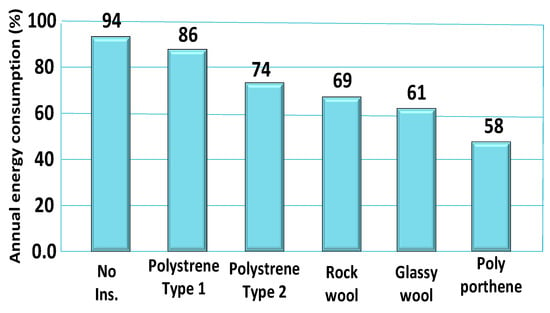
Figure 6.
Effect of insulations quality on energy consumption.
Figure 7 shows the effect of insulation of walls and ceilings on electricity consumption reduction. This figure compares the effectiveness of different insulation types—walls only, ceiling only, and both combined—in reducing electricity consumption as a percent. The results show that insulating both walls and ceilings yields the highest energy savings, achieving a 25% reduction in electricity use. Wall insulation alone provides a moderate 16% reduction, while ceiling insulation alone offers a smaller benefit of 9%. This highlights that comprehensive insulation—covering both major surfaces—significantly enhances thermal performance and energy efficiency in buildings.
On the other hand, Figure 8 illustrates the effect of thermal insulation thickness on annual energy consumption (%) for different insulation scenarios: ceiling only, walls only, and both combined. As insulation thickness increases from 0 to 8 cm, energy consumption decreases for all cases, demonstrating the effectiveness of added insulation in improving energy efficiency. The greatest reduction is observed when both walls and ceilings are insulated, reducing energy use to approximately 76% at 8 cm thickness. Wall-only insulation shows a moderate improvement, while ceiling-only insulation results in the least savings. This highlights that increasing insulation thicknesses, especially in both walls and ceilings, significantly reduces energy demand, supporting more sustainable and cost-effective building operation.
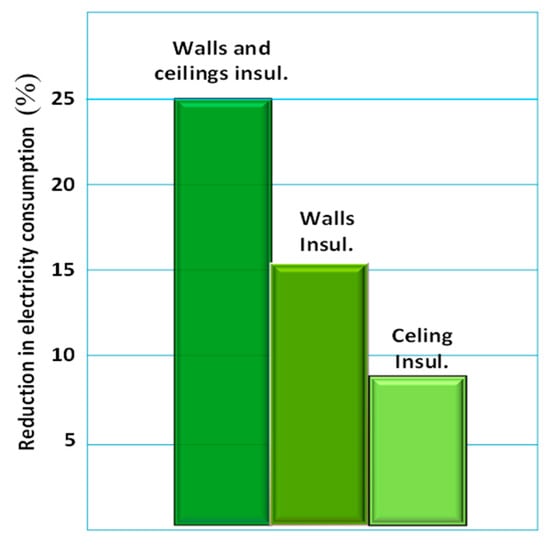
Figure 7.
Effect of insulation of walls and ceilings on electricity consumption reduction.

Figure 8.
Effect of thermal insulation thickness on annual consumption energy consumption.
6.2.4. Effect of EER upon Energy Conservation
In Saudi Arabia, the Saudi Standards, Metrology and Quality Organization (SASO) has established Minimum Energy Performance Standards (MEPS) for air conditioners to enhance energy efficiency and reduce electricity consumption. These standards are detailed in SASO 2663:2021 [34,35,36], which specifies the minimum required Energy Efficiency Ratio (EER) values for various types and capacities of air conditioning units [34,35,36]. The EER is the ratio of output cooling capacity of the unit divided by the unit power input and can be defined by the following formula [23]:
where:
1 W = 3.41 BTU/h
Figure 9 shows the minimum Energy Efficiency Ratio (EER) prescribed by the Saudi Arabian Standard Organization (SASO) for all electric products need to satisfy and abide by for Saudi Arabia at the specified prevailing temperature in summer season. Therefore, the minimum EER should be set at 8.5 at room temperature 46 °C for all appliances and equipment, such as air-conditioners, refrigerators, and washing machines. Moreover, SASO stipulates that a star rating, between a minimum of one and a maximum of six (the higher the number of stars means the higher the energy efficiency level and the least cost), be displayed on the energy label affixed to the product.
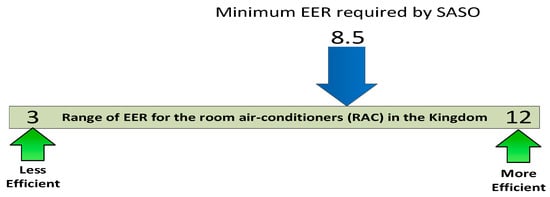
Figure 9.
Energy Efficiency Ratio (EER) with specified minimum level according to the Saudi standards.
The precedent thoughts presented in this section demonstrate to what extent the savings in energy consumption can be attained when adopting and applying the EER index for the air-conditioners since these equipment consumptions constitute the largest energy share among the other equipment. Hence, this action, when applied along with other actions to the case of the RRB, will certainly relieve it from a power deficit (nearly 18 MW), as previously mentioned in Section 2 and revealed by Figure 1. Hence, after performing the assessment required for the evaluation of the merits and benefits that may accrue from adopting a value for the EER to be set at 11.8, and by using Equation (1), the resulting outcome of the analysis is exhibited in Table 7 and Figure 10, which reveal a saving in the annual energy consumption reaching 28.40%. This saving, with other saving manipulations attempted in this study, contributes to mitigating the power deficits and relieving energy shortages that the RRB faces suffers from at the present time.

Table 7.
Effect of the EER on energy conservation.
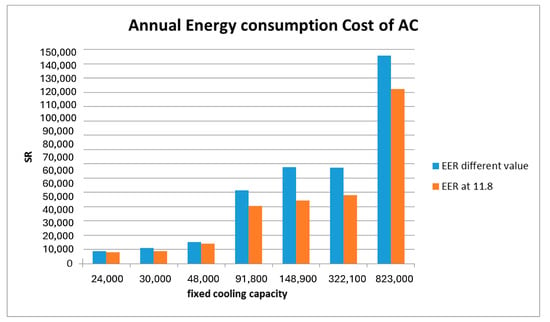
Figure 10.
Effect of the EER on energy cost reduction.
6.3. Effect of Controlling the Operation of Water Heaters
The average water heating may exceed 30% of the gross consumed energy in the RRB during winter season where there are over 1300 water heaters installed at various locations with an estimated total power at nearly 5 MW. The results of using timers for switching off the water heaters at sleeping time (11:00 pm–7:00 am) have been summarized in Table 8 and portrayed by Figure 11.

Table 8.
Effect of controlling water heater operation.
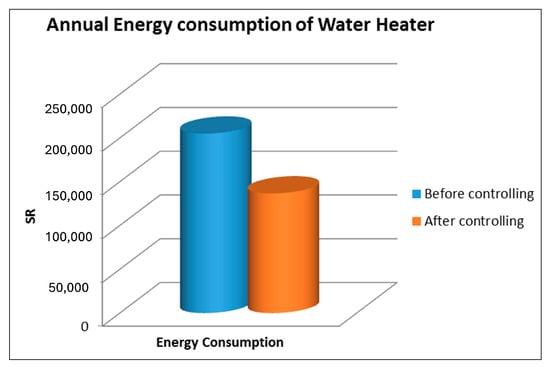
Figure 11.
Saving water heating by using heating control.
6.4. Effects of Applying All Measures Proposed in the Study to the RRB Energy Saving
At the last and final stage of this work, it is advantageous to wrap up all proposed ideas discussed in this work concerning proper energy management and conservation at the Riyadh Reformatory Building (RRB) as case study. Therefore, eQUEST has been used to incorporate all the specifications, stipulations and provisions presumed for the RBB energy conservations involved in this work (e.g., building locations and sizes, window types and properties, AC equipment, lighting types, insulation types, water heaters). The adopted methodology was based on the comparison between the monthly energy cost before and after implementation of the conservation methodology by using eQUEST simulation software. The outcome findings have been summarized in Table 9 as well as exhibited in Figure 12 which shows significant energy conservation and persuasive cost saving.

Table 9.
Overall annual energy conservation and saving.

Figure 12.
Effect of applying overall energy conservation measures in reducing energy cost.
7. Challenges and Policy Implications in Institutional Energy Conservation
The key challenges associated with implementing energy conservation measures and achieving cost-effectiveness in institutional settings, particularly in the context of large-scale facilities, such as the Riyadh Reformatory Building (RRB) were identified as follows:
- High Initial Capital Costs:
While long-term energy savings are substantial, many energy-efficient upgrades, such as high-performance insulation, advanced HVAC systems, and smart control technologies—require significant upfront investment. This poses a barrier, especially for public sector institutions with limited or rigid budgets.
- 2.
- Operational and Maintenance Constraints:
Institutional buildings often operate continuously and house diverse activities, making it difficult to implement energy-saving shutdowns or load adjustments without disrupting core services.
- 3.
- Behavioral and Administrative Factors:
Energy misuse due to lack of awareness among staff and occupants remains a persistent issue. As observed in RRB, appliances are often left running during non-operational hours, contributing to avoidable energy consumption.
- 4.
- Technological Integration Barriers:
Integrating modern systems (e.g., IoT, AI-based controls) into legacy infrastructure can be complex and may require additional retrofitting, skilled personnel, and IT infrastructure.
- 5.
- Policy and Compliance Gaps:
Although national codes like the Saudi Building Code (SBC) and SASO standards provide clear guidelines, enforcement and monitoring in institutional buildings are not always consistent. Stronger policy enforcement, along with incentives or subsidies, could accelerate adoption of high-efficiency technologies.
8. Conclusions
This study presents a comprehensive energy conservation strategy tailored for institutional buildings, using the Riyadh Reformatory Building (RRB) as a real-world case study. Through detailed simulations using the eQUEST software, the study evaluated the impact of various building design and operational parameters on total energy consumption. The results provide compelling evidence of the significant savings achievable through targeted interventions.
The main conclusions are as follows:
- Lighting Efficiency:
Replacing conventional lighting systems (incandescent, halogen, and fluorescent) with LED technology achieved a 74% reduction in lighting energy consumption, which also contributed to reducing cooling loads and associated costs.
- 2.
- High-Efficiency HVAC Systems:
Upgrading air conditioners to units that comply with higher Energy Efficiency Ratio (EER) standards led to a 28.4% reduction in annual energy consumption, underscoring the critical role of EER compliance in hot climates.
- 3.
- Thermal Insulation and Glazing:
Implementing high-quality insulation materials (such as polyurethane) and using double-shaded reflective glass significantly reduced thermal losses, resulting in up to 36% overall energy savings from building envelope improvements.
- 4.
- Smart Controls and Behavioral Adjustments:
Introducing programmable thermostats and scheduling water heater operations led to additional energy savings of 5.1% and 33%, respectively, demonstrating the benefits of control-based energy management.
- 5.
- Overall Impact:
The integration of all proposed measures resulted in an overall energy savings of 41% annually, effectively reducing the RRB’s energy demand and mitigating its ongoing power deficit.
This work highlights the practical viability and economic value of adopting a multi-faceted energy conservation strategy in institutional buildings. The study also emphasizes the importance of aligning building operations with national energy standards (SASO and SBC Part 803).
Looking forward, the study recommends integrating AI-enhanced smart sensors and automated control systems to further optimize energy performance through real-time monitoring, predictive analytics, and adaptive operation. Such advancements will support the transition toward intelligent, energy-resilient institutional infrastructures in Saudi Arabia and similar climatic regions.
Author Contributions
Conceptualization, A.A.-A., H.M.H.F. and A.A.A.-S.; Methodology, A.A.-A., H.M.H.F. and A.A.A.-S.; Software, A.A.-A.; Validation, A.A.-A.; Formal analysis, A.A.-A., H.M.H.F. and A.A.A.-S.; Investigation, A.A.-A., H.M.H.F. and A.A.A.-S.; Resources, A.M.A.-S.; Writing—original draft, A.A.-A. and H.M.H.F.; Writing—review & editing, A.M.A.-S., H.M.H.F. and A.A.A.-S.; Supervision, H.M.H.F. and A.M.A.-S.; Project administration, H.M.H.F. and A.M.A.-S.; Funding acquisition, H.M.H.F. All authors have read and agreed to the published version of the manuscript.
Funding
This work was supported and funded by the Deanship of Scientific Research at Imam Mohammad Ibn Saud Islamic University (IMSIU) (grant number IMSIU-DDRSP2503).
Institutional Review Board Statement
Not applicable.
Informed Consent Statement
Not applicable.
Data Availability Statement
The data presented in this study are available on request from the corresponding author.
Conflicts of Interest
The authors declare no conflicts of interest.
References
- Available online: https://www.seec.gov.sa/en (accessed on 22 April 2025).
- Printed in Saudi Arabia. The Saudi Building Code; Saudi Arabia, 2007. Available online: http://faculty.ksu.edu.sa/ashuraim/Documents/SBC306C_FEB_2008_FINAL.pdf (accessed on 22 April 2025).
- Rodrigues, C.A.; Gabriel Filho, L.R.A.; de Oliveira, S.C.; Gabriel, C.P.C.; Halmeman, M.C.R. Fuzzy logic application in the evaluation of energy efficiency in buildings in Brazil. Acta Sci. Technol. 2025, 47, e70529. [Google Scholar] [CrossRef]
- Huang, Y.; He, Z.; Qin, Y.; Lu, Y.; Chen, K. Optimizing office building performance in the HSWW region of China using simulation with Hyperopt CatBoost and SPEA2. Sci. Rep. 2025, 15, 8193. [Google Scholar] [CrossRef] [PubMed]
- Zhang, Y.; Wang, B. Study on indoor thermal environment and energy consumption of traditional dwellings of ethnic minorities in Sichuan plateau. Sci. Rep. 2025, 15, 8109. [Google Scholar] [CrossRef] [PubMed]
- Liu, X.; Zhang, H.; Pan, Y.; Ma, J.; Liu, C.; Shen, C. A Transparent Polymer-Composite Film for Window Energy Conservation. Nano-Micro Lett. 2025, 17, 151. [Google Scholar] [CrossRef]
- Jettanasen, C.; Thongsuk, S.; Sottiyaphai, C.; Songsukthawan, P.; Chiradeja, P.; Lertwanitrot, P.; Ananwattanaporn, S.; Ngaopitakkul, A. An approach to energy conservation in lighting systems using luminaire-based sensor for automatic dimming. Sci. Rep. 2025, 15, 3302. [Google Scholar] [CrossRef]
- Shakhovska, N.; Mochurad, L.; Caro, R.; Argyroudis, S. Innovative machine learning approaches for indoor air temperature forecasting in smart infrastructure. Sci. Rep. 2025, 15, 47. [Google Scholar] [CrossRef]
- Liang, X.; Liu, Y.; Chen, S.; Li, X.; Jin, X.; Du, Z. Physics-informed neural network for chiller plant optimal control with structure-type and trend-type prior knowledge. Appl. Energy 2025, 390, 125857. [Google Scholar] [CrossRef]
- Kolokotsa, D.; Tsoutsos, T.; Papantoniou, S. Energy conservation techniques for hospital buildings. Adv. Build. Energy Res. 2012, 6, 159–172. [Google Scholar] [CrossRef]
- Al-Shaalan, A.M. Proposed Measures to Mitigate Energy Interruptions in Residential Sector. J. Power Energy Eng. 2017, 5, 50–63. [Google Scholar] [CrossRef]
- Al-Shaalan, A.M. Investigating Practical Measures to Reduce Power Outages and Energy Curtailments. J. Power Energy Eng. 2017, 5, 21–36. [Google Scholar] [CrossRef]
- Snead, B. Energy Efficiency and Conservation in the Residential, Commercial and Industrial Sectors; Final Report; Kansas State University: Manhattan, KS, USA, 2006. [Google Scholar]
- Gabbar, H.A. Energy Conservation in Residential, Commercial, and Industrial Facilities; Gabbar, H.A., Ed.; John Wiley & Sons: Hoboken, NJ, USA, 2018. [Google Scholar]
- Marshall, M.J. Social-Psychological Correlates of Household Energy Conservation Activities. Ph.D. Dissertation, The Claremont Graduate University, Claremont, CA, USA, 1987. [Google Scholar]
- McMakin, A.H.; Malone, E.L.; Lundgren, R.E. Motivating residents to conserve energy without financial incentives. Environ. Behav. 2002, 34, 848–863. [Google Scholar] [CrossRef]
- Shimoda, Y.; Asahi, T.; Taniguchi, A.; Mizuno, M. Evaluation of city-scale impact of residential energy conservation measures using the detailed end-use simulation model. Energy 2007, 32, 1617–1633. [Google Scholar] [CrossRef]
- De Dear, R.; Brager, G.S. The adaptive model of thermal comfort and energy conservation in the built environment. Int. J. Biometeorol. 2001, 45, 100–108. [Google Scholar] [CrossRef] [PubMed]
- Fujii, E.T.; Mak, J. A model of household electricity conservation behavior. Land Econ. 1984, 60, 340–351. [Google Scholar] [CrossRef]
- Diakaki, C.; Grigoroudis, E.; Kabelis, N.; Kolokotsa, D.; Kalaitzakis, K.; Stavrakakis, G. A multi-objective decision model for the improvement of energy efficiency in buildings. Energy 2010, 35, 5483–5496. [Google Scholar] [CrossRef]
- Gobinath, J.; Kumar, M.V.; Lenin, M. Recent approach for energy conservation and user fulfillment using automated led lighting system in buildings through wireless network. In Proceedings of the 2013 International Conference on Green Computing, Communication and Conservation of Energy (ICGCE), Chennai, India, 12–14 December 2013; IEEE: Piscataway, NJ, USA; pp. 28–33. [Google Scholar]
- Center, Saudi Energy Efficiency. Mandatory Application of Energy Efficiency Ratio (EER) on Major Electrical Equipment; Annual Report; SEEC: Riyadh, Saudi Arabia, 2020. [Google Scholar]
- Abdulaziz Almarzooq, S.; Al-Shaalan, A.M.; Farh, H.M.; Kandil, T. Energy conservation measures and value engineering for small microgrid: New hospital as a case study. Sustainability 2022, 14, 2390. [Google Scholar] [CrossRef]
- Alrubaih, M.S.; Zain, M.F.M.; Ibrahim, N.L.N.; Alghoul, M.A.; Sauod, K.B. The Energy Impacts of Using Top-Light Daylighting Systems for Academic Buildings in Tropical Climate. Int. J. Environ. Ecol. Eng. 2012, 6, 642–645. [Google Scholar]
- Pérez-Lombard, L.; Ortiz, J.; Pout, C. A review on buildings energy consumption information. Energy Build. 2008, 40, 394–398. [Google Scholar] [CrossRef]
- Lai, C.M.; Wang, Y.H. Energy-saving potential of building envelope designs in residential houses in Taiwan. Energies 2011, 4, 2061–2076. [Google Scholar] [CrossRef]
- Alajlan, S.A.; Smiai, M.S.; Elani, U.A. Effective tools toward electrical energy conservation in Saudi Arabia. Energy Convers. Manag. 1998, 39, 1337–1349. [Google Scholar] [CrossRef]
- Melo, A.P.; Cóstola, D.; Lamberts, R.; Hensen, J.L.M. Assessing the accuracy of a simplified building energy simulation model using BESTEST: The case study of Brazilian regulation. Energy Build. 2012, 45, 219–228. [Google Scholar] [CrossRef]
- Kamal, M.A. A study on shading of buildings as a preventive measure for passive cooling and energy conservation in buildings. Int. J. Civ. Environ. Eng. 2010, 10, 19–22. [Google Scholar]
- El-Kady, M.A.; Shaalan, A.M. Integrated utility-consumer strategies for demand management and energy conservation. In Proceedings of the Joint Engineering Committee/KACST/IEE/IEEE Workshop on Energy Conservation and Load Management, Riyadh, Saudi-Arabia, May 1997. [Google Scholar]
- Chowdhury, A.A.; Rasul, M.G.; Khan, M.M.K. Thermal-comfort analysis and simulation for various low-energy cooling-technologies applied to an office building in a subtropical climate. Appl. Energy 2008, 85, 449–462. [Google Scholar] [CrossRef]
- Al-Mofleh, A.; Taib, S.; Mujeebu, M.A.; Salah, W. Analysis of sectoral energy conservation in Malaysia. Energy 2009, 34, 733–739. [Google Scholar] [CrossRef]
- Al-Homoud, M.S.; Abdou, A.A.; Budaiwi, I.M. Assessment of monitored energy use and thermal comfort conditions in mosques in hot-humid climates. Energy Build. 2009, 41, 607–614. [Google Scholar] [CrossRef]
- Available online: https://www.saso.gov.sa/ar/Laws-And-Regulations/public_multimedia/Documents/SASO%20DRAFT%202663-0000.pdf?utm_source (accessed on 5 June 2025).
- Available online: https://saso.gov.sa/ar/mediacenter/events/Documents/201216_SEER%20Workshop.Vpresented.pdf?utm_source (accessed on 5 June 2025).
- Saudi Energy Efficiency Center (SEEC). Introducing the New Requirements of Air Conditioners Standard SASO-2663 the Seasonal Energy Efficiency Ratio (SEER); SEEC: Riyadh, Saudi Arabia, 2020. [Google Scholar]
Disclaimer/Publisher’s Note: The statements, opinions and data contained in all publications are solely those of the individual author(s) and contributor(s) and not of MDPI and/or the editor(s). MDPI and/or the editor(s) disclaim responsibility for any injury to people or property resulting from any ideas, methods, instructions or products referred to in the content. |
© 2025 by the authors. Licensee MDPI, Basel, Switzerland. This article is an open access article distributed under the terms and conditions of the Creative Commons Attribution (CC BY) license (https://creativecommons.org/licenses/by/4.0/).